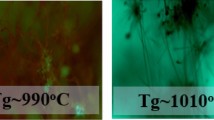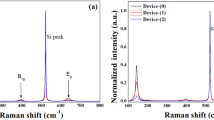Abstract
This report presents the VLS synthesis and the study of the charge carrier transport through defect states across the interface in ZnO/In2O3 composite nanostructures using temperature-dependent optical as well as the electrical properties. CNs were synthesized at two distinct temperatures, 980 °C and 1000 °C using vapor–liquid–solid technique (VLS). High-resolution transmission electron microscopy (HRTEM) images indicate the formation of granules of ZnO and In2O3 in CNs equal in number. XPS results confirmed the concentration of defect states in CNs affecting the vibrational and translational modes related to the defect states evaluated in Raman spectroscopy. The PL spectrum of the ZnO/In2O3 CNs showed an enhanced visible band in comparison to the pure ZnO and In2O3 PL spectrum. Furthermore, the contribution of defect states were determined using PL and PLE analysis. The visible region was deconvoluted to determine the contributions from Zn interstitial (InZn~2.1–2.2 eV), oxygen vacancies (Vo~2.4–2.5 eV), Indium interstitial (InIn ~ 2.0–2.1 eV), and ionized oxygen vacancies (Vo+~1.77–1.93 eV) in pure ZnO and In2O3, respectively. Temperature-dependent PL (TPL) (30 K to 450 K) measurement determined the anomalous behavior of integrated intensities of green (Vo), yellow (InIn), and orange emission (InIn) bands. The Berthelot equation determined the activation energy, escape energy, and Berthelot energy of these emission bands which described the role of defects in charge transport process across the interface of ZnO/In2O3 heterojunction. Results were further confirmed from the temperature-dependent current–voltage (I–V–T) measurements of thin-film heterojunction at high temperature (315 K to 473 K). At low temperature electrons move from conduction band (CB) of ZnO to CB of In2O3. At high temperature the charges accumulated at CB-In2O3 moved to CB-ZnO due to high escape energy. Charge transport took place through defect states following path from InIn-In2O3 to Vo-ZnO, determined using activation energies.









Similar content being viewed by others
Data availability
The datasets generated during and/or analyzed during the current study are available from the corresponding author on reasonable request.
References
P. Mahajan, A. Singh, S. Arya, J. Alloys Compd. 814, 152292 (2020)
N. Badi, Y. Al-Douri, S. Khasim, Opt. Mater. 89, 554 (2019)
J. Kim, S. Shrestha, M. Souri, J.G. Connell, S. Park, A. Seo, Sci. Rep 10, 1 (2020)
M. Das, M. Patra, R.G. Bhagavathiachari, R.G. Nair, Mater. Chem. Phys 263, 124431 (2021)
A.R. Kirmani, E.F. Roe, C.M. Stafford, L.J. Richter, Adv. Mater 1, 167 (2020)
A. Das, M. Patra, M. Bhagavathiachari, R.G. Nair, Mater. Chem. Phys 263, 24431 (2021)
S.P. Smrithi, N. Kottam, V. Arpitha, A. Narula, G.N. Anilkumar, K.R.V. Subramanian, J Sci-Adv Mater Dev. 5, 73 (2020)
C. Karthikeyan, P. Arunachalam, K. Ramachandran, A.M. Alayouf, S. Karuppuchamy, J. Alloys Compd. 828, 154281 (2020)
R. Ghosh, D. Basak, S. Fujihara, J. Appl. Phys 96, 2689 (2004)
R. Sabry, M. Fikry, O.S. Ahmed, A.R.N. Zekri, A.F. Zedan, J. Phys. Conf. Ser 1472, 012005 (2020)
M. Ramsteiner, J. Feldl, Z. Galazka, Semicond Sci Technol 35, 015017 (2019)
Q.K. Doan, M.H. Nguyen, C.D. Sai, H.H. Mai, N.H. Pham, T.C. Bach, V.T. Nguyen, T.T. Nguyen, K.H. Ho, T.H. Tran, Appl. Surf. Sci 505, 144593 (2020)
F. Saeed, A. Farooq, A. Ali, S. Mehmood, C. Cepek, S. Bhardwaj, A. Hamid, A.S. Bhatti, Mater. Sci. Eng. 262, 114781 (2020)
R.L.D.S. Silva, A. Franco Jr., Mater Sci Semicond Process 119, 105227 (2020)
M.M. Khan, R. Siwach, S. Kumar, J. Ahmed, M. Ahamed, J. Alloys Compd 846, 56479 (2020)
S. Rajpal, S.R. Kumar, Solid State Sci. 108, 106424 (2020)
F. Gao, J. Yuan, X. Huang, R. Lei, C. Jiang, J. Zhuang, P. Liu, Chem Eng J. 416, 129159 (2021)
C. Han, X. Li, Y. Liu, X. Li, C. Shao, J. Ri, J. Ma, Y. Liu, J. Hazard. 403, 124093 (2021)
Z. Jia, S. Ren, J. Zhang, J. Wang, Acta Photonica Sinica 50, 150004 (2021)
S. Wang, X. Wang, G. Qiao, X. Chen, X. Wang, H. Cui, Sens. Actuators B Chem 341, 130002 (2021)
L. Aziz, N. Sabih, S. Mehmood, A. Ali, M.U. Hassan, A.S. Bhatti, Ceram. Int. 46, 9794 (2020)
B. Huang, Z. Zhang, C. Zhao, L. Cairang, J. Bai, Y. Zhang, X. Mu, J. Du, H. Wang, X. Pan, J. Zhou, Sens. Actuators B Chem 255, 2248 (2018)
Acknowledgements
The author is very thankful to CMND (COMSATS University Islamabad) for providing experimental facilities. The author would like to thank teachers, colleagues, and lab technicians of CMND. Special thanks to Namal Institute Mianwali.
Funding
No funding was received for this work.
Author information
Authors and Affiliations
Contributions
MS has done synthesis, characterization, first draft preparation, and approval of final version, while ZR has been involved in improving quality of manuscript, proof reading, and review and revision of the manuscript. FS has helped in characterization and improving the overall quality of the manuscript. FFS helped in improving quality of manuscript.
Corresponding author
Ethics declarations
Conflict of interest
The authors declare no conflict of interest. This work was performed during PhD.
Additional information
Publisher's Note
Springer Nature remains neutral with regard to jurisdictional claims in published maps and institutional affiliations.
Rights and permissions
About this article
Cite this article
Sabeen, M., Rehman, Z.u., Saeed, F. et al. Understanding the charge transfer and defect states in ZnO/In2O3 composite nanostructures (CNs). J Mater Sci: Mater Electron 33, 4951–4964 (2022). https://doi.org/10.1007/s10854-021-07684-7
Received:
Accepted:
Published:
Issue Date:
DOI: https://doi.org/10.1007/s10854-021-07684-7




